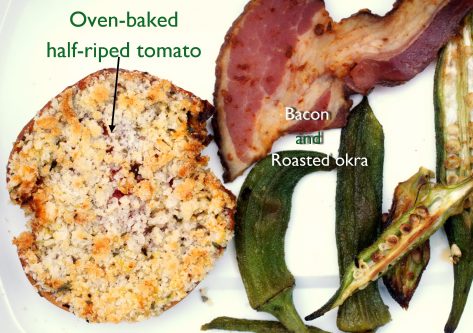Baked Green, and Not-So-Green, Tomatoes

Leftovers from a dinner of oven-baked green and half-ripened tomatoes, roasted okra, and fried bacon, a happy threesome if there ever was one.
One evening, I burnt the tip of my left index finger while frying green tomatoes in a cast-iron pan. Instead of using a spatula to flip the cornmeal-dusted rounds, I got right in there, with my fingers. Now, a week and half later, the spot looks like the veneer on an old piece of furniture, yellowed and crackled, and feels like dried wax, as if I’d had a run-in with a molten candle instead of hot bacon grease.
The altered condition of my fingertip made me think of a film I saw some years ago called Illégal in which the main character, Tania, deliberately burns her fingertips on a hot clothes iron to obliterate her finger prints. She does this to avoid identification, after slipping into France for better work opportunities, and to avoid deportation, if she is found out.
This spring I applied for entry in the Global Entry program that allows for speedier clearance into the U.S. upon returning from foreign travel. As part of the application process, your photo is taken and your fingerprints scanned. I used it the first time this June, when returning from a trip to France. It worked beautifully.
I suppose my finger will heal and return to its former self, with its imprint left unchanged. But I don’t know. The next time I use the Global Entry kiosk, and place my fingertips on the fingerprint scanner, will sirens go off and sniffer dogs appear out of nowhere? Will they wonder what I am trying to get past them?
Professional chefs use their hands when cooking all the time. Touch, along with the other senses of sight, smell, hearing, and taste, are all utilized. As a result, they get used to the heat, and their fingers become permanently padded and calloused. This, is at least, what I’ve picked up from reading chefs’ memoirs and books about cooking in general, and taking the random chef-taught cooking class.
The difference between chefs’ and my use of hands-on cooking is this: I believe chefs touch food to get a sense of doneness rather than use their hands to flip food in a super-hot pan. They likely know enough to use the right tool for the right job, which isn’t always fingertips, unlike me (= stupid).
My misapplied use of touch in the kitchen didn’t last long. I had successfully flipped on a few green tomato slices before I reflexively whipped my hand back and yelped in pain, and finished cooking the rest of the meal one-handed with the injured finger in a glass of ice water.
All of this makes me wonder if a career in cooking leaves chefs with incognito fingerprints, then maybe a life of espionage or high-stakes diamond theft is a logical second employment option for them, once they’ve burnt out on kitchen work. Are chefs overlooking a lucrative golden age career path? Mabye.
* * * * * * * * * * * * * * * * * * * * * * * * * * * *
Despite having sacrificed a fingertip to frying green tomatoes, at the end of the day, I wasn’t happy with the results, even after two attempt using two different types of coatings (one cornmeal and the other breadcrumbs). The results simply didn’t match the fried green tomatoes I’ve had at restaurants, where they’ve always arrived perfectly breaded and fried with a crusty exterior. My husband said, “Why don’t you bake them?” This was a very acceptable solution, and we do need a solution to successfully cooking them because our end-of-season garden plot still has a few straggler green tomatoes waiting to be eaten.
Note about green, and not-so-green, tomatoes.
I noticed that when picked green, tomatoes will ripen a bit sitting on the counter, though they never taste as good, of course, as a garden-ripened tomato, and their texture is ever so slightly soft when ripened this way. But when the sugars are allowed to work their magic even just a little bit, evidenced in a color change from completely green to pale pink transitioning to red, the tomatoes taste sweet when baked. Because I picked green tomatoes in stages, I ended up with an assortment of fully green tomatoes to half-ripened ones when I had enough to do one pan full. Both sorts work well for this preparation, and have a very different taste: the green being completely tart, and half-ripened ones having the classic tomato taste we’re all accustomed to. Fully ripened tomatoes should not be used because they are too soft.
To make baked green, and not-so-green, tomatoes.
Preheat the oven to 450°F. Grease a sheet pan.
Crack an egg in a bowl, add a couple pinches of salt, and whisk well. Place breadcrumbs in another bowl and season well with salt and pepper as well as other any other seasoning(s) you like, such as a dried herb blend or a combination of ground spices. Slice green and/or half-ripened tomatoes into rounds, about ¼-inch thick.
Dip a slice into the beaten egg, then into the breadcrumbs to coat well on both sides. Place on the greased sheet pan. Repeat with the rest of the tomato slices.
Let the slices sit for about 10 minutes on the sheet pan, then place in the hot oven in a middle rack. Bake for about 8 minutes, then remove the pan from the oven and flip the slices over (use your fingers if you dare, but I don’t advise it . . .). Return to the oven and bake for another 5 minutes, then turn the oven to the broil setting to brown the tops, a few minutes.
